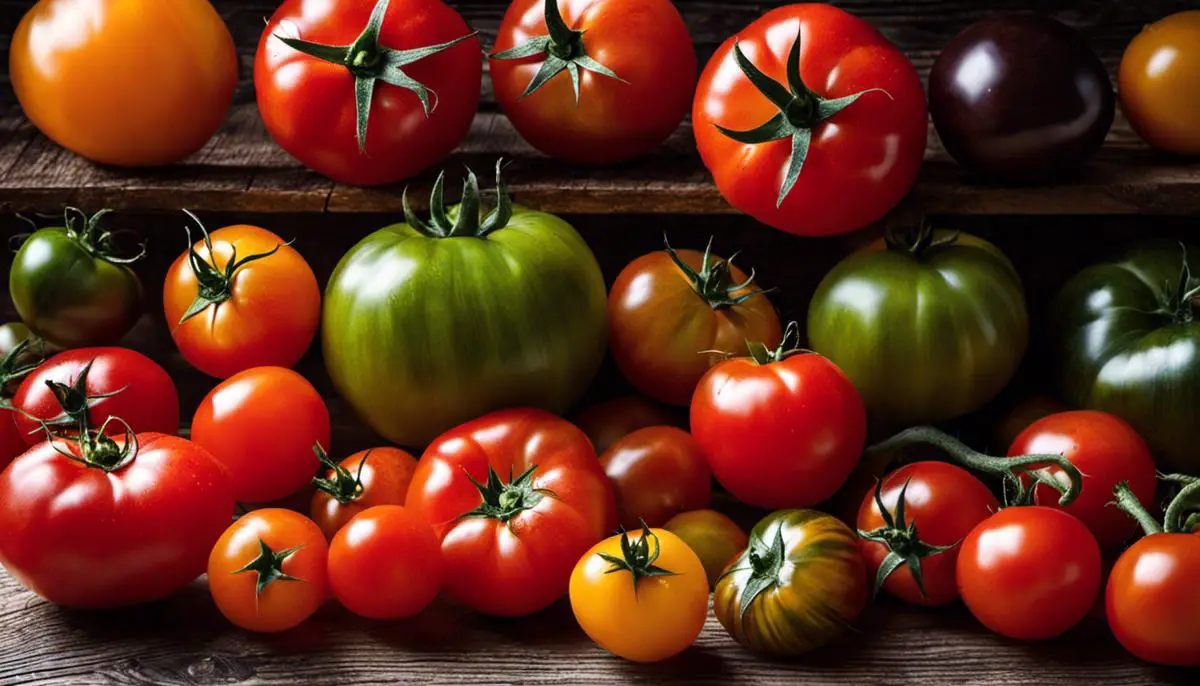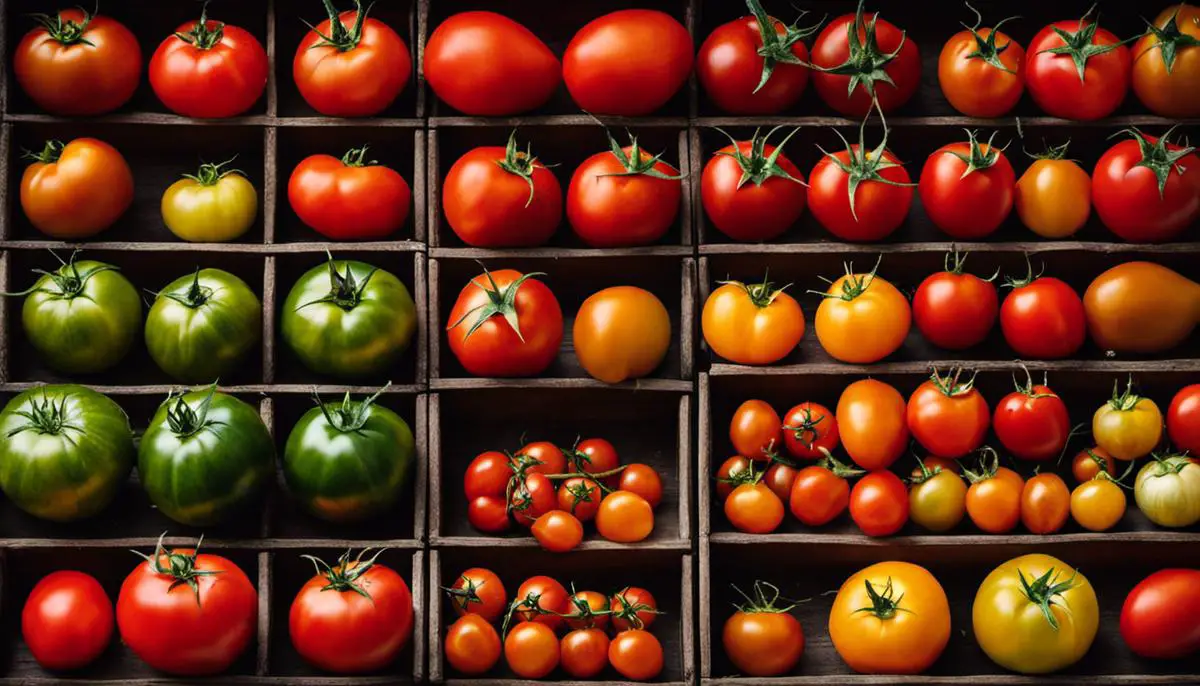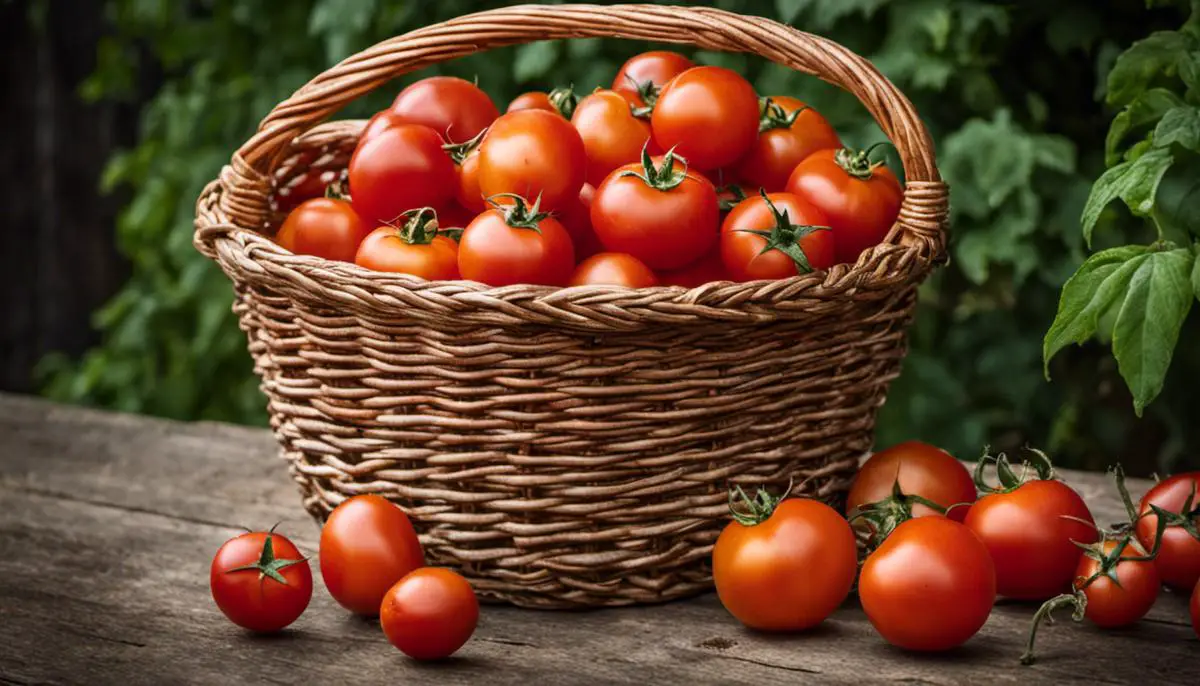Table of Contents
Gardening enthusiasts agree that nothing compares to the taste of a ripe, homegrown tomato fresh from their own backyards. Whether you’re new to gardening or simply want to enhance your expertise, this writing offers comprehensive guidance on cultivating garden tomatoes. From selecting the perfect variety to fit your taste and circumstances, to planting and caring for your tomato plants, and finally, harvesting and storing the fruits of your labor. Our aim is to equip you with all the knowledge you need to turn your garden into a tomato oasis.
Choosing the Right Tomato Varieties
Understanding Tomato Varieties
Tomatoes are one of the most popular fruits often grown in home gardens due to their wide range of varieties, each carrying distinct tastes and growth properties. Two basic types are determinant and indeterminate tomatoes. Determinant tomatoes, also known as bush tomatoes, are compact in nature. They tend to stop growing when the top bud of the plant reaches its fruit-bearing stage. Typically, determinant tomatoes ripen all at once, making them a preferred choice for those who enjoy canning.
On the other hand, indeterminate tomatoes, often labeled as vining tomatoes, can grow up to 12 feet, hence requiring supportive structures. Unlike determinant tomatoes, these offer a longer harvesting period as they continue to produce fruit until frost kills the plant.
Tomato Varieties and Taste
The flavor of tomatoes is significantly influenced by the specific variety you choose to cultivate. Certain types like the ‘Brandywine’ are notorious for bearing large, pink fruits with an exceptionally sweet and smoky flavor. Another sought-after variety is the ‘Sun Gold’ that produces orange-yellow cherry tomatoes, loved for their tangy taste. On the opposite end of the flavor spectrum lies the ‘Green Zebra,’ known for its tart flavor profile, delivering green-ripe fruits with darker green stripes.
Choosing Disease-Resistant Varieties
Resistance to diseases is another crucial factor to consider while selecting the right tomato variety for your home garden. Several hybrids have been developed to withstand common tomato diseases such as ‘Big Beef’ which resists Tomato Yellow Leaf Curl Virus and Verticillium wilt. ‘Iron Lady,’ a newly developed variety, shows resistance to late blight, early light, and Septoria leaf spot.
Climate-Specific Tomato Varieties
Some tomato varieties are more suited to specific climatic conditions than others. Cool climate gardeners are usually recommended varieties like ‘Stupice’ and ‘Glacier,’ since they’re cold-hardy and can tolerate less-than-ideal temperatures and shorter growing seasons. For warmer climates, heat-tolerant varieties like ‘Solar Fire’ or ‘Summer Set’ are more suitable as they can withstand temperatures of over 90 degrees Fahrenheit and still set fruit.
Tomato Types and their Uses
Lastly, the type of tomato also determines its culinary application. Larger beefsteak varieties like ‘Big Rainbow’ or ‘Cherokee Purple’ are ideal for slicing and make a great addition to sandwiches and salads. Roma or Paste tomatoes like ‘San Marzano’ are thick-fleshed, making them perfect for sauces and canning. Small-fruited cherry tomatoes such as ‘Sweet Million’ or ‘Yellow Pear’ make excellent salad tomatoes due to their bite-size nature and sweetness.
To augment your home gardening experience, selecting the appropriate tomato varieties that meet your bespoke requirements is vital, setting the stage for a flavorful and productive yield.

Planting and Caring for Your Tomato Plants
Guide to Selecting Your Perfect Tomato Variety
In your garden, there is a plethora of tomato varieties for you to sow, each possessing its own distinctive flavor, size and purpose. Some of the crowd-favorite varieties include the Beefsteak renowned for its large and succulent tomatoes, Roma or Plum tomatoes ideal for creating scrumptious sauces and pastes, and the small but delicious Cherry tomatoes perfect for salads and quick bites. You may also explore Heirloom tomatoes, which are open-pollinated varieties boasting unique flavors and eye-catching colors.
When to Plant Your Tomatoes
The timing for planting tomatoes will depend on your local climate and the variety of tomato chosen. Generally, tomatoes should be planted outdoors in the garden after all risk of frost has passed and when the soil temperature has consistently reached 60°F (16°C). For most locations in the US, this is usually in late spring or early summer. If you want to get a jump start on the growing season, you can plant tomato seeds indoors 6-8 weeks before the last expected frost date.
Preparing Your Soil
Tomatoes thrive in well-drained, nutrient-rich soil. Prepare your garden by adding organic compost to the top 3-4 inches of your garden soil. This will increase fertility and improve soil structure. Or, if you’re planting in containers, use a high-quality, prefertilized potting mix specifically designed for tomatoes. The soil pH should ideally be 6.2 to 6.8 as tomatoes prefer a slightly acidic soil.
Spacing and Planting Your Tomatoes
The spacing between tomato plants is critical to their health and productivity. In general, plants should be spaced 24-36 inches apart in a row with the rows spaced 48 inches apart. However, this can vary depending on the particular variety you choose. When planting, dig a hole deep enough to submerge 2/3 of the plant, including the lower sets of leaves, this promotes a strong root system.
Watering Your Tomato Plants
Tomato plants require regular, deep watering to produce fruit and prevent diseases. Generally, tomato plants need about 1-1.5 inches of water a week. If your garden doesn’t receive enough rainfall, you’ll need to water manually. It’s best to water them early in the morning at the soil level to minimize leaf wetness and prevent disease development.
Preventing Disease and Pests
Tomatoes can be prone to a number of diseases and pests. Some common diseases that affect garden tomatoes include blight, fusarium wilt, and blossom end rot. Regular inspection of your plants can help detect any issues early and allow for effective treatment. Some of the common pests that can affect tomato plants include aphids, hornworms, stink bugs, and cutworms. Using organic pesticide sprays, introducing beneficial insects, and employing crop rotation can help deter pests and keep your plants healthy.
Pruning and Supporting Your Tomatoes
Pruning and supporting your tomatoes can increase sun exposure and air circulation, leading to healthier plants and better fruit. Removing all but the top two or three branches of the plant can boost the yield and size of your tomatoes. Moreover, using stakes, trellises, or cages to support your tomato plants can prevent them from falling over and keep the fruit off the ground, reducing the chance of disease.
Harvesting Your Tomatoes
Typically, tomatoes are ready for harvest when they’ve achieved their full size and rich color. Depending on the variety, this could range from 60 to 85 days after planting. The ripe fruit should gently twist off the vine with a small pull, and frequent harvesting of ripe tomatoes not only prevents waste but encourages the plant to yield even more.

Harvesting and Storing Tomatoes
Determining the Ideal Harvest Time for Your Tomatoes
Perfect timing is essential in harvesting garden tomatoes. A tomato at peak ripeness will usually exhibit a vibrant, uniform color and feel soft. The ripe fruit should come off the vine with little effort. It’s also good to note, the size of a ripe tomato varies between varieties, so it’s best to depend on color and texture for judgment.
If you’re working with heirloom tomatoes, the ripening process starts from the bottom and gradually moves upward. With red varieties, you can optionally harvest as soon as the tomatoes turn pink; however, holding off until a deep red shade ensures maximum flavor.
Method of Harvesting Tomatoes
Harvest your garden tomatoes by holding them at the stem and gently twisting the fruit off. Avoid pulling directly on the fruit as this could be disruptive to the plant and lead to damaged fruit. For stubborn fruit, you may use garden pruning scissors to cut the stem above the fruit.
Storing Freshly Harvested Tomatoes
After harvesting, avoid refrigerating tomatoes as this can lead to changes in texture and loss of flavor. Cold temperatures can break down the cell wall structure of the tomato, leading to a mushy texture and diminished flavor.
Instead, tomatoes should be stored at room temperature, in a single layer, away from direct sunlight. Place tomatoes stem-side down on a flat surface, allowing the “shoulders” of the tomato to bear the fruit’s weight. This can help prevent further ripening and potential bruising.
Storing Unripe Tomatoes
Unripe tomatoes can be ripened off the vine if necessary. If the fruit is green but firm with a hint of pink, it can be placed on a windowsill or countertop out of direct sunlight. In about a week or two, the tomato will begin to change color and ripen.
For green, hard tomatoes, they can be wrapped individually in newspaper or be placed in a paper bag and stored in a cool, dark place. Check them often because as one starts to ripen they will all start to ripen.
Long-Term Storage of Tomatoes
If you have a surplus of tomatoes and want to store them for future consumption, consider preserving them. Canning tomatoes is a traditional method of long-term storage. This involves placing washed and prepared tomatoes in sterilized jars and heating them to kill microbes that can cause decay.
Another method is freezing tomatoes. The tomatoes need to be washed and cored, then placed in sealable freezer bags. When you’re ready to use them, let them thaw, and peel the skin off. They’re perfect for cooking, but won’t maintain the same texture for use in salads.
Remember, proper harvesting and storage of tomatoes are critical to maintaining their taste and nutritional value. The goal is to maximize your yield and enjoy your tasty garden tomatoes for as long as possible.

After planting and tending to your garden tomato plants with care and patience, there is nothing more satisfying than enjoying the fruits of your labor. Remember, in gardening, as in life, patience is a vital virtue. It takes time for your tomatoes to grow from tiny seeds into flourishing plants that yield ripe, flavorful fruits. But with the right knowledge on selection, planting, and care, as well as strategies for harvesting and storage, you can look forward to an abundant and rewarding tomato harvest each year. Happy tomato gardening!
